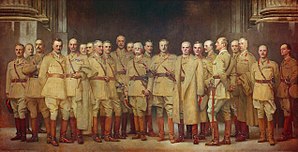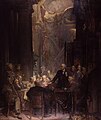General Officers of World War I.

|
| General Officers of World War I. |
|---|
| John Singer Sargent , 1922 |
| Oil on canvas |
| 299.7 x 528.3 cm |
| National Portrait Gallery, London |
General Officers of World War I (generals of World War I) is a painting by John Singer Sargent (1856-1925) from the year 1922. It is now in the National Portrait Gallery in London . John Singer Sargent was considered the most important American portrait - painter of his time. The original name for the painting was Some General Officers of the Great War (Some generals of the Great War) .
prehistory
Shortly after the end of the First World War , the South African financier Abraham Bailey (1864–1940) commissioned three life-size group portraits from the National Portrait Gallery in London , which were intended to recognize the great importance of Great Britain's army , navy and politicians for victory in World War I . Bailey offered to pay £ 5,000 (about £ 230,000 today) for each of the three paintings and to donate them to the National Portrait Gallery upon completion. The Chairman of the Board of Trustees , Harold Arthur Lee-Dillon , then turned to John Singer Sargent in December 1918 and asked him whether he would be willing to take on any of these pictures despite his expressed intention to withdraw from portraiture. Lee-Dillon emphasized that this commission would be the most important of its kind that the gallery had ever done. Therefore, one will break one rule and allow portraits of living celebrities as an exception. Although Bailey would pay for the paintings himself, he left the museum's board of trustees to decide which people should be portrayed and which artists would do the work. The naval and military groups should contain about twenty figures each, and the statesmen group about fifteen.
Sargent replied to Lee-Dillon a few days later that it was with great regret that he had to decline the offer. He was commissioned by the Museum of Fine Arts in Boston to design a wall decoration for a public building, which is why he will spend the next two to three years overseas. Lord Dillon asked Sargent to reconsider his decision, stressing the historical significance of the group portraits and assuring him that he would have absolutely free hand in the selection of the painting and its execution. After Sargent had been guaranteed that he could adapt the work on the painting to his other obligations and count on support at the meetings to be held, he accepted the commission in early January 1919 and decided to paint a group portrait with the leading generals of the First World War. Although Sargent found the assignment a burden and feared failure, he devoted himself to the task with all his might. Two portraitists were soon found for the other two paintings. James Guthrie (1859-1930) painted Statesmen of World War I and Arthur Stockdale Cope (1857-1940) created Naval Officers of World War I . All three group portraits are still part of the National Portrait Gallery's collection today.
Preliminary work

James Milner, the director of the National Portrait Gallery, organized Sargent's initial meetings with the generals so that he could do preparatory work before traveling to America in May 1919. When he returned to England in July 1920, he made further sketches and portrait studies. Difficulties arose from the fact that meetings could no longer be arranged for some of the generals. Both Frederick Stanley Maude and Louis Botha had died before Sargent began work on the painting. It is not known how Maude's posthumous portrait was created. For Botha, Sargent based himself on Guthrie's bust portrait, which Guthrie had made for the painting of the statesmen. For the portrait of Andrew Hamilton Russell , Sargent had to use a newspaper clipping to create a portrait because Russell had been sick or absent on the scheduled meeting times. Probably because of this inadequacy, Sargent placed Russell in the back row.
From January to October 1921, Sargent stayed in America again and worked on his mural. The exact chronology of the individual sessions can no longer be precisely reconstructed. Numerous studies in oil paint are likely to have been made between 1919 and 1921. Sargent also made pencil drawings in which he worked out the poses of the people portrayed. He often made a note of the sitter's height. Most of the generals' oil studies have been preserved in various collections and seventeen pencil drawings are in the National Portrait Gallery.
Portrait studies (selection)
completion

After returning to London in the autumn of 1921, Sargent continued to work on the group portrait, but was hampered by the poor winter light and long-lasting fog. Sargent apparently had great problems developing an overall concept for the positioning of the generals and the surrounding space. According to his own admission, he was hampered by the notion that the sitters had never gathered in a particular place. Therefore, he has no background as a template and must paint the generals as if in a vacuum. In contrast to Cope and Guthrie, who arranged the admirals and statesmen in their portraits vividly and in relation to one another, Sargent decided not to introduce a similar narrative motif. Rather, he grouped the individual portraits next to one another without establishing a relationship between the figures.
The generals are shown standing roughly in line, with their heads all on a similar level, against a neutral architectural background. This room, with its large classical plinths and fluted columns, is almost certainly an invention of the artist. The generals themselves are all uniformly depicted in khaki uniforms and wearing sabers and spurs. The Marshals are on their marshal's batons to detect. The ranking of the portrayed is reflected in their position. In the center are the two commanders in chief on the Western Front , John French on the right and his successor Douglas Haig on the left. On the left side of the picture are u. a. Pictured are Army Commanders of the Western Front and Chief of Staff Henry Hughes Wilson . Sargent was able to complete the painting in the course of 1922. In the same year it was exhibited at the Royal Academy . It was then brought to the National Portrait Gallery, where it has been exhibited to the present day without interruption. Today the work is in room 31 (Britain 1914–59) together with the other two group portraits.
The generals of the Great War
Pictured from left to right are:
- Field Marshal William Birdwood, 1st Baron Birdwood ( Commander of the Australian and New Zealand Army Corps from 1914 to 1916 and the British Fifth Army in 1918)
- Field Marshal Jan Smuts (Commander of the Armed Forces in British East Africa 1916)
- General Louis Botha (Commander in South West Africa )
- Field Marshal Julian Byng, 1st Viscount Byng of Vimy (Commander of the British Third Army from 1917 to 1918)
- General Henry Rawlinson, 1st Baron Rawlinson ( British Fourth Army commander 1916-1918)
- Major-General Sir Henry Lukin (commander of the 1st South African Infantry Brigade from 1915 to 1916 and the 9th (Scottish) Division from 1916 to 1918)
- General Sir John Monash (commanding the Australian Corps from 1917 to 1918)
- General Henry Horne, 1st Baron Horne (Commander of the British First Army from 1917)
- Field Marshal George Milne, 1st Baron Milne (Commander of the British Forces on the Salonika Front from 1916 to 1918)
- Field Marshal Henry Wilson, 1st Baronet ( Chief of the Imperial General Staff from February 1918)
- Major-General Sir Andrew Hamilton Russell (Commander of the New Zealand Division from 1916 to 1918)
- Field Marshal Herbert Plumer, 1st Viscount Plumer (Commander of the British Second Army from 1915 to 1917 and again in 1918)
- General Sir John Cowans ( Quartermaster-General to the Forces from 1912 to 1919)
- Field Marshal Douglas Haig, 1st Earl Haig (Commander in Chief of the British Expeditionary Force in France from 1915 to 1918)
- Field Marshal John French, 1st Earl of Ypres (Commander in Chief of the British Expeditionary Force in France from 1914 to 1915)
- Field Marshal Sir William Robertson, 1st Baronet (Chief of the Imperial General Staff from 1915 to 1918)
- Lieutenant-General Sir Frederick Stanley Maude (Commander of the British Forces on the Mesopotamia Front from 1916 until his death in 1917)
- Field Marshal Edmund Allenby, 1st Viscount Allenby (Commander of the British Third Army from 1916 to 1917 and the Egyptian Expeditionary Force in the Middle East )
- Lieutenant-General Sir William Marshall (Commander of the British Forces on the Mesopotamia Front from 1917 to 1918)
- General Sir Arthur Currie ( Canadian Corps Commander 1917-1918)
- Field Marshal Rudolph Lambart, 10th Earl of Cavan (Commander of the 10th Italian Army from 1918)
- General Sir Charles Macpherson Dobell (Commander in Cameroon from 1914 to 1916 and then in the Middle East until 1917)
reception
When presented at the National Portrait Gallery, the portrait received only moderate acclaim. Sargent's reservations about his work have been echoed by some critics. Sargent only provided a number of portraits in a common frame. In contrast to the work of Guthrie and Cope, Sargent had failed to create the impression that the generals were ever so assembled. The generals would be completely isolated from one another. As a statement about military leadership, the picture might be appropriate, but the generals would appear like puppets waiting for someone to pull the strings or like a choir stepping into the limelight. The representation of individual people with their finely designed faces was praised. The large columns with their broad bases and fluted column shafts are just as impressive . Sargent was therefore charged with apparently more interested in the pillars than in his generals. Overall, the painting is a collection of portraits, but not a picture.

The group portrait was apparently reproduced and disseminated as requested by Abraham Bailey. A 46 cm high and 31 cm wide photo engraving is located in Chartwell , Winston Churchill's former country house in Kent , now a National Trust museum. The black and white illustration is labeled Some General Officers of the Great War . The caption states Abe Bailey as the founder and John Singer Sargent as the artist.
More paintings from the series
Abraham Bailey had commissioned two other group portraits from the National Portrait Gallery:
literature
- Gary Sheffield: General Officers of World War I. In: Dictionary of National Biography . Oxford University Press.
Web links
- National Portrait Gallery of London: General Officers of World War I
- National Portrait Gallery of London: Room 31: Britain 1914–59









